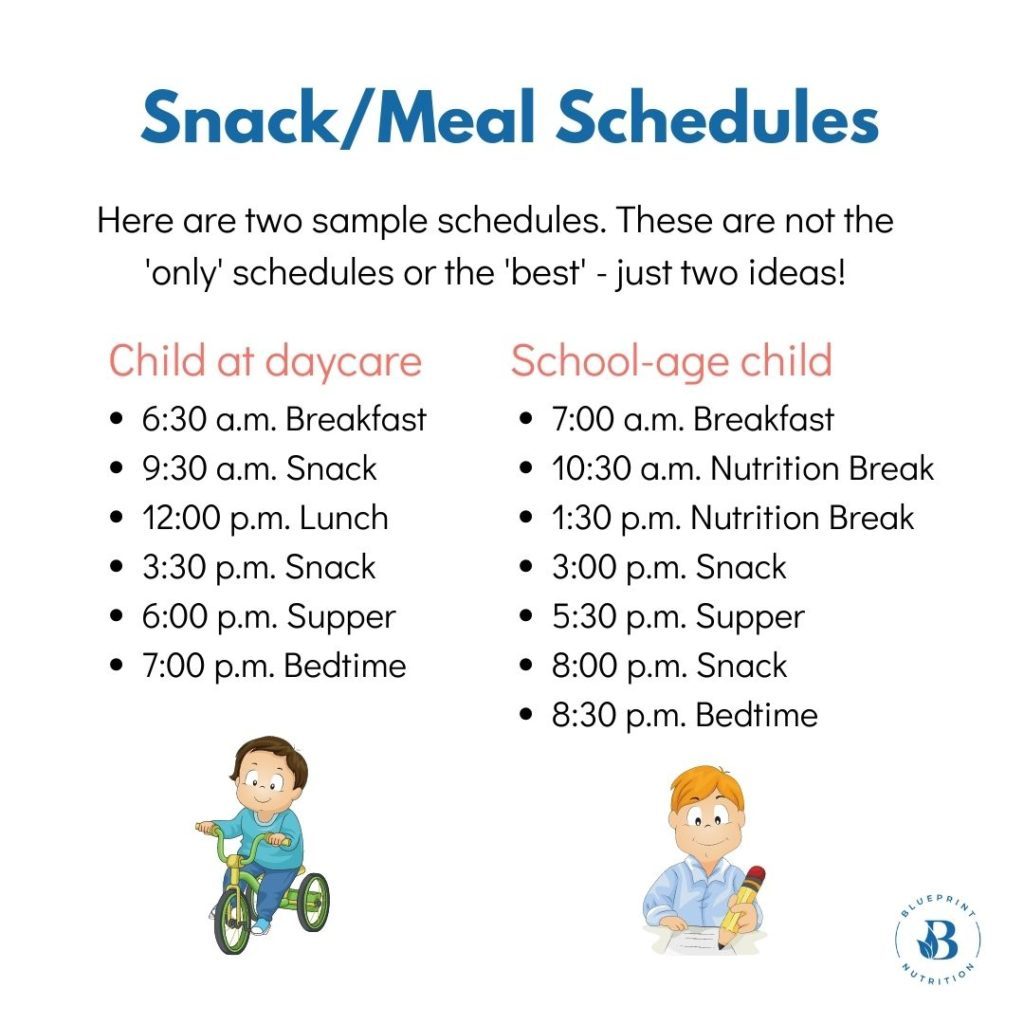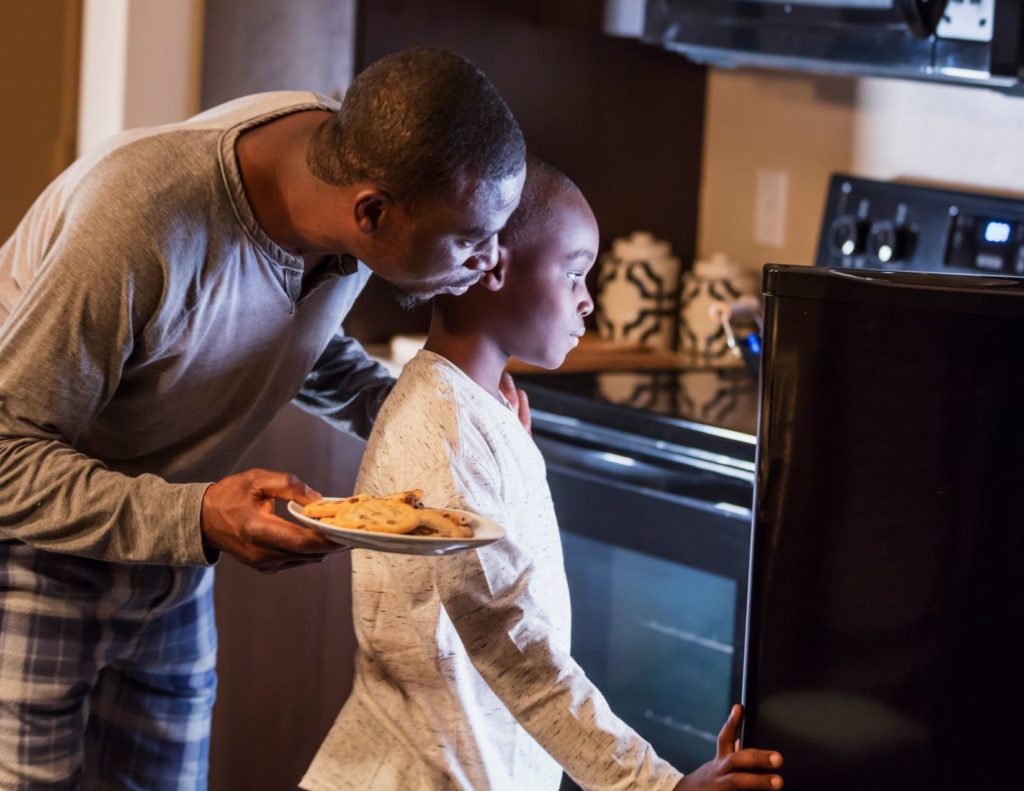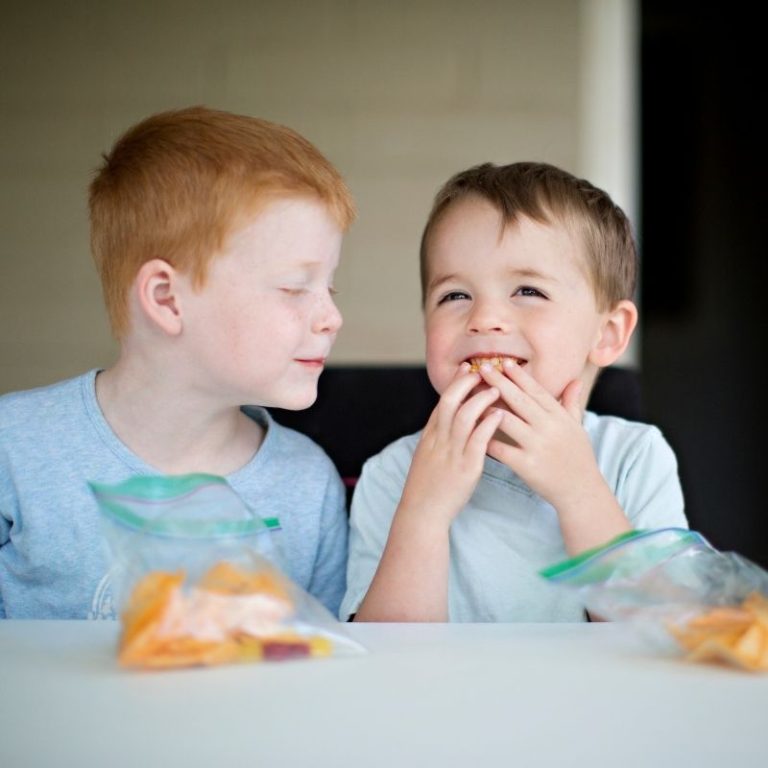Kids and snacks – these two things go together like peanut butter and jelly! I get asked a lot about navigating snacks with kids. In fact, questions related to snacking are among the most common questions that I am asked by my clients, as well as family, friends and strangers too!
For some families, snacking is a non-issue. Snack times are a pleasant morning or afternoon break shared together. For other families, however, snacks are a major source of stress and conflict. This tension arises from a few different places.
In recent years I have observed more and more how much child-targeted snacks mixed with the strong messages around ‘good’ and ‘bad’ foods for kids are colliding and contributing to parent’s worries about their children’s snacking habits. There is pressure coming from all sides, angles and directions. It’s hard to know what to do or think about snacks (and food in general).
While this is another blog post for another day, I do want to tell you that snacking, though often demonized in our culture, is an important part of a child’s overall nutrition. Snacking can actually support the building blocks for a positive relationship with food.
Whatever your current snack struggle may be, snacks aren’t going away anytime soon so it’s important to tackle these questions head on. When you feel confident in your approach to snacks, it will only help facilitate a joyful eating environment and trust in the feeding relationship.
Kids and Snacks: The Top 5 Q&A!
Here are my answers to the 5 most commonly asked questions that I get about kids and snacks!
Question #1 – How many snacks should my kid have in a day?
Well, that depends. (You’ll hear me say that a lot because unfortunately, nutrition is not black and white like some people think). It depends on many factors, including your child’s age, activity level, growth patterns, the school/home schedule etc. There is no “right” number of snacks to give your child.
However, having said that, here are some general guidelines that you may find helpful. I can’t emphasize enough that these are general guidelines. Every child is unique.
- Younger children: 2-3 snacks daily
- Older children: 1-3 snacks daily
Most toddlers, preschoolers and younger school-age children need 2-3 snacks. Older children may only need 1 snack but I find that most need a minimum of 2. Oftentimes having more than 3 snacks in a day (aka lots of grazing) compromises a child’s appetite at the next mealtime.
When working with families, I often recommend that they develop a consistent meal and snack schedule. I find that kids do best when a consistent eating routine is in place.

You may find that certain days will require different snack schedules. For instance, if your daughter has hockey practice at 5:30 p.m., you may opt to skip your regular after school snack and have an early supper at 4:30 p.m. and then offer a larger bedtime snack/mini meal after the practice. Alternatively, you could offer a bigger after school snack, then eat a late supper and skip bedtime snack.
Question #2 – My kid asks for a lot of snacks. How can I tell if he or she is just bored or actually hungry?
This is such a popular question that I wrote a blog post on the topic last year. Here are a few things you might want to consider on this topic.
- Consider adopting a schedule, as we discussed above. When you set specific times for meals and snacks to occur, you naturally build non-eating gaps in the day, which helps kids tune into their hunger and fullness cues and thus to tease apart boredom vs. hunger. You’re not starving your children if you say no to a snack request. You’re allowing them to learn the signs and signals of hunger and fullness. This enables them to eat intuitively by allowing them to develop hunger between eating opportunities. Having a schedule actually cultivates intuitive eating skills for kids.
- Be okay with saying “not right now” OR “the kitchen isn’t open right now”. This is simply stating a fact. “We’re not eating now. We will eat again later though. Let’s do something else.” Remember that when following the division of responsibility, as the caregiver, you’re responsible for deciding what is eaten, where it is eaten and WHEN it is eaten.
- Serve satisfying snacks. (Hint! Scroll down to question #5 for some tips here!) Filling snacks help to keep kids satiated for longer periods of time. This means that you will hear fewer requests for food in between scheduled meals/snacks.
- Avoid distractions while eating. This is hard right now with parents working and kids learning virtually at home. Sometimes you’ve gotta do what you gotta do. If possible though, practice eating as many meals/snacks as possible without technology present. It’s easier for kids to eat until they are satisfied if they are not distracted.
Question #3 – Is a bedtime snack a good idea or should kids not eat after supper?

I’m neutral about bedtime snacks. They work for some families and they don’t for others. I don’t think it’s a question of right or wrong. Rather, it’s a question of what works for your family and your kids.
I recommend that families either offer a bedtime snack or not. Choose one or the other to decrease the constant requests. However, if your family is anything like mine, flexibility is key. Bedtime snacks appear some nights and don’t other nights as our supper hour fluctuates due to activities.
Here is a general rule of thumb or guideline you can use to help with your decision: if supper is 2 or more hours away from bedtime then you may want to consider offering it. However, if supper is at 6 p.m. and your child is in bed at 7 p.m., then it’s likely not needed. Again, every child is different.
In terms of what to offer for a bedtime snack, just remember the “triple B” method – otherwise known as Balanced & Boring at Bedtime snack. It’s not the time to pull out something super exciting for your child or to turn the bedtime snack into dessert.
Question #4 – What should I do if my child asks for a snack 10 minutes after a meal? Can I serve them their uneaten meal for snack?
Kids are smart aren’t they?! Asking for food after a meal – whether it’s 5 minutes after the meal or 30-60 minutes after the meal is not uncommon. Especially if you have a picky eater at home who was not impressed with the offer on the table and left after eating only a few bites.
Should you give them food after the meal? Well, that depends. For most garden variety selective or picky eaters I would say no. Not if it isn’t a set snack time. Stick to your schedule and wait until the next planned eating opportunity. If it’s a meal they haven’t learned to like yet on the table, I recommend adding 1 or 2 preferred or safe foods to the dinner table that night. For example, if you’re serving a soup they do not like, perhaps offer milk to drink or some bread and butter or their favourite raw veggie on the veggie platter with dip so there is something they enjoy.
For more extreme picky eaters, or kids with high food phobia or anxiety around food, we need an individualized approach.
Can you (or should you) offer them their leftover supper plate if they say they’re hungry 5 minutes after supper?
Generally, I advise not to do this. Most families, if they offer the supper plate again, will enter into a battle with the child over the uneaten food and this causes more damage to the feeding relationship. We don’t want food or the supper table to be a place of angst for our kids or else they will never feel at ease to be adventurous and try new foods.
Food and eating should not evoke feelings of hatred, shame, guilt or inadequacy in our kids. If offering leftover supper to your child is promoting any of these feelings, don’t do it.
On the other hand, if you have a really trusting and positive feeding relationship with your child and they simply have an ‘off’ meal and request food right away after the meal, if done lovingly, you can offer them more supper or let them know that otherwise the kitchen will open again at the next eating opportunity (e.g. bedtime snack or breakfast in the morning).
Question #5 – What makes for a filling snack? Can I offer candy with snack?
All foods are good foods but they are even better when you pair them with their best partners! If your child is asking for snacks all the time then it may be that their current meals or snacks are missing satiating power!
So what makes for a filling snack combo? Pairing a carbohydrate along with a protein and/or fat. So, a granola bar on its own won’t last nearly as long as perhaps a granola bar with some Greek yogurt. Let me give you a few more satiating snack examples:
- Cheese and crackers with veggies
- Yogurt with berries and nuts or seeds
- Veggies and pitas dipped in hummus or tzatziki
- Toast with nut butter and banana slices
- Smoothie with yogurt, fruit, and chia seeds or frozen avocado
- Popcorn with butter or oil
I think that it is perfectly fine and actually important to offer foods higher in salt or sugar alongside the snack ideas listed above on some days. So go ahead and throw a few smarties on a snack plate or some pretzels or whatever your kids enjoy. Serving these foods regularly actually helps to decrease their “superstar status” and foster a good relationship with all foods.
As is recommended by Ellyn Satter, Feeding Therapist and Registered Dietitian, a great way to help your child become more relaxed and less fixated on “forbidden” foods is periodically offering an unlimited portion of this food (e.g. a plate of cookies) or salt (e.g. chips) at snack times and enjoy it together.
Now I’d love to hear from YOU! What are some snacking scenarios or questions that you have run into with your own kiddos at home?






